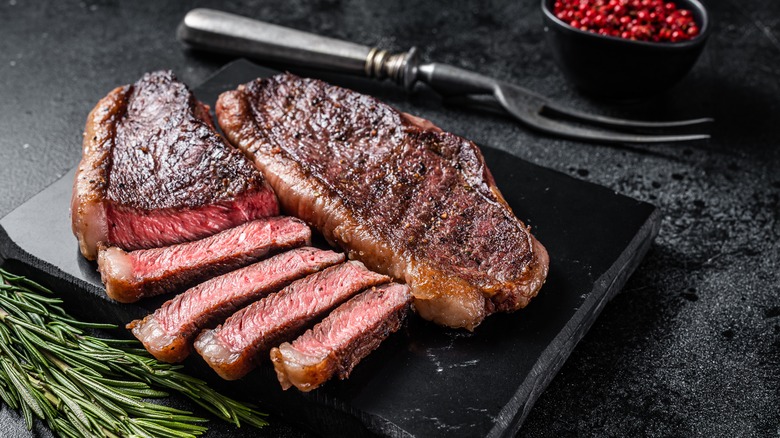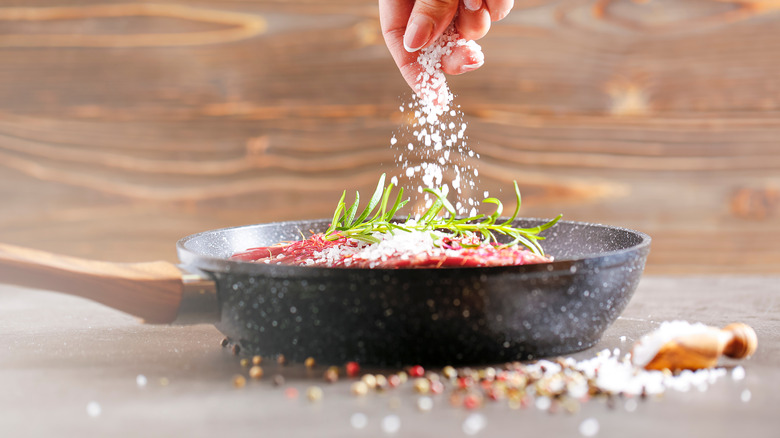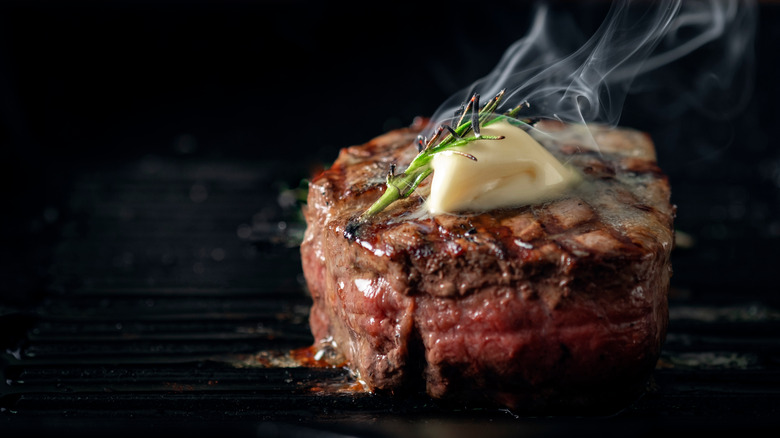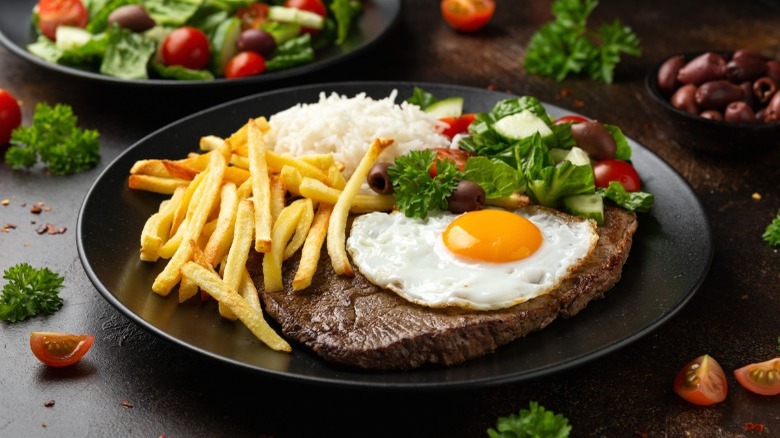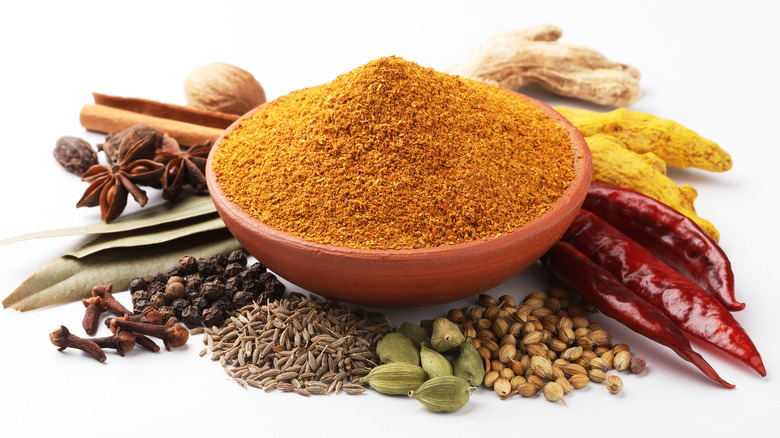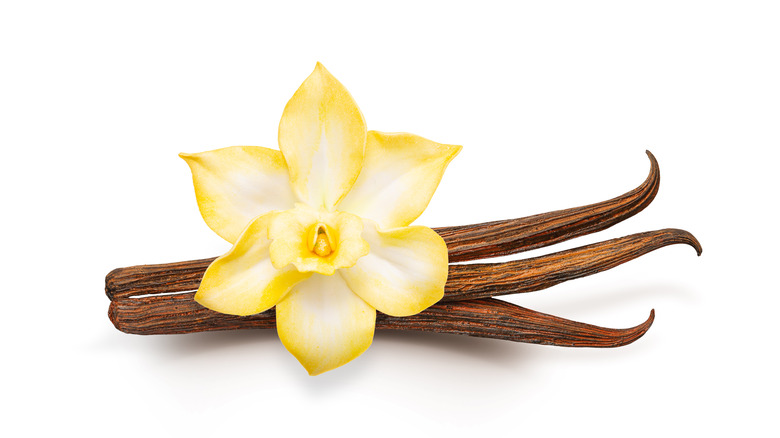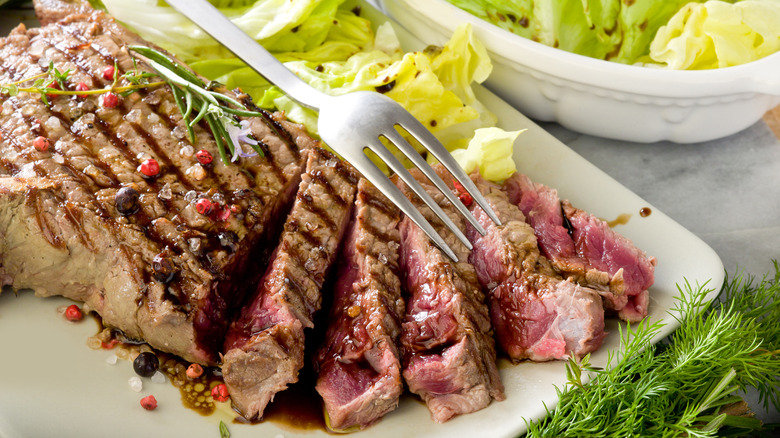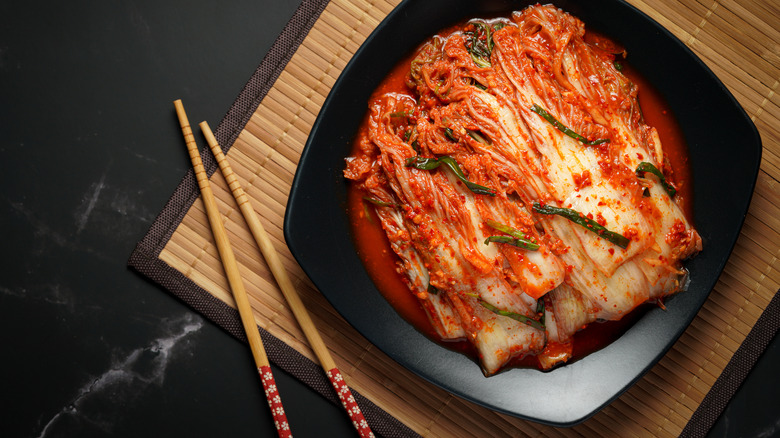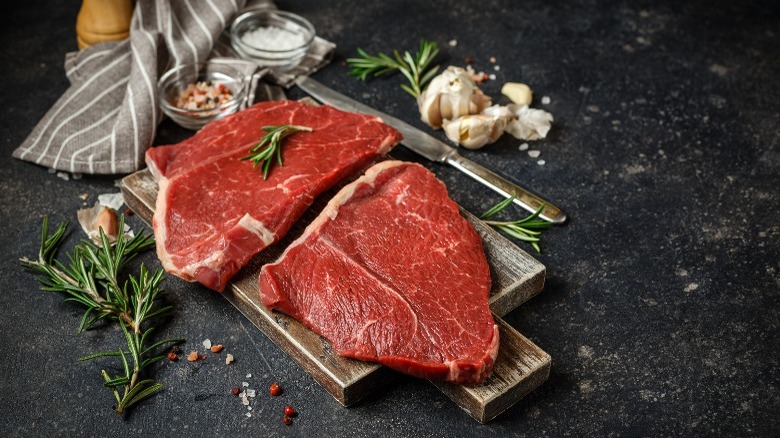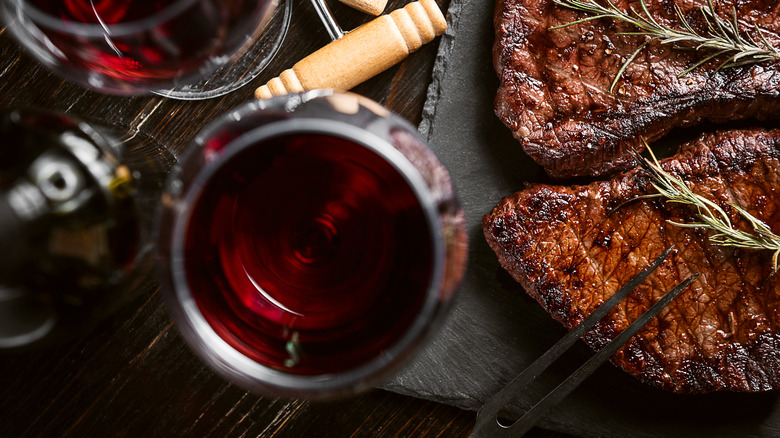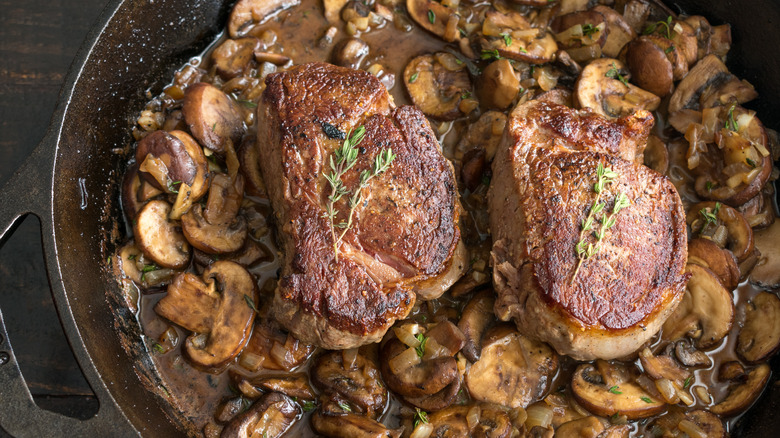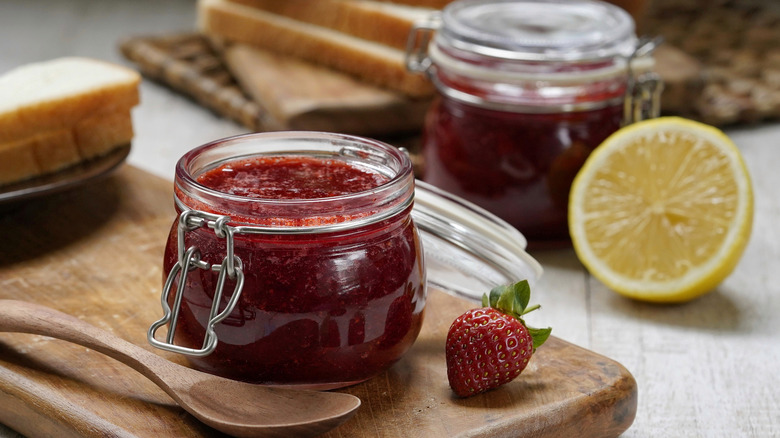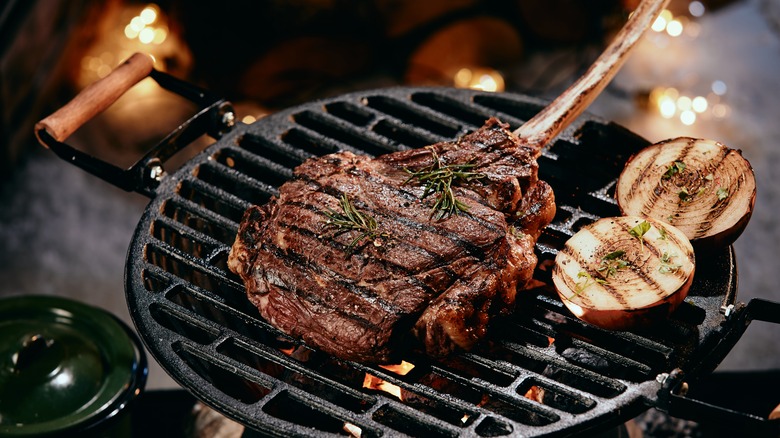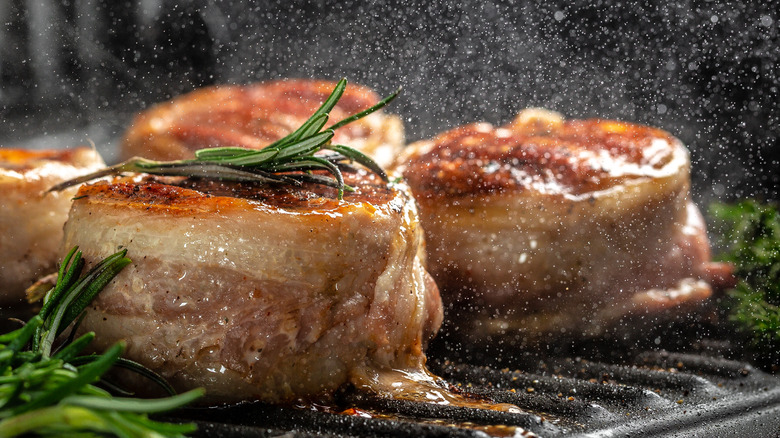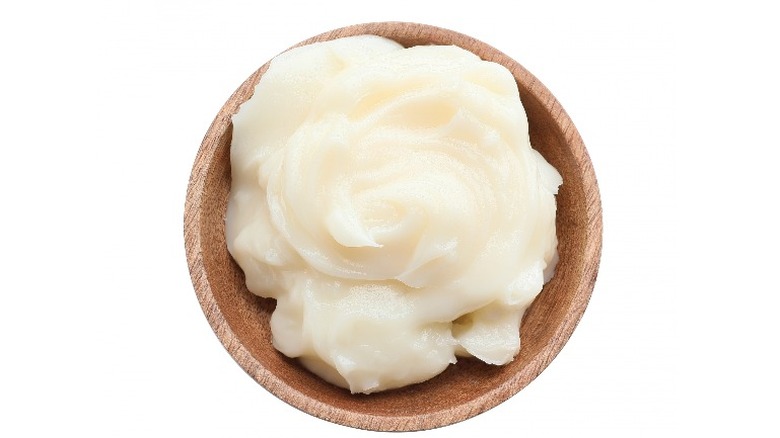15 Ingredients That Will Seriously Elevate Your Steak
Some say that a perfectly seared (or grilled) high-quality steak needs nothing else. That may be true for steak purists, but there are a few things that can take an average steak to the next level. Whether it's a simple seasoning or a flavorful sauce, even the best steaks can benefit from a little extra flavor. While the first bite of a juicy, rich steak is delicious enough on its own, by the tenth bite your mouth may be craving something a little more interesting.
Sometimes it's a blend of rich spices, other times, a piquant sauce. A boost of flavor can turn a cheap, average steak into a mouthwatering meal that you'll enjoy to the last bite. Even pricey dry-aged cuts can benefit from the right kind of side sauce or spice rub. Whether you're looking to "wow" your dinner party guests or just jazz up a weeknight dinner, read on for the best ingredients to elevate your steak.
Salt
Anyone who has ever cooked beef knows that you need to at least season it with some salt. But this simple ingredient is so important that it bears repeating. It may seem simple, but not using the right amount and type of salt is likely one of the biggest mistakes you're making with steak. Most people know they need to use at least a little bit of salt when cooking beef, but it's hard to know exactly what to do if you're a bit of a cooking novice.
All steaks benefit from a generous application of salt. Using too little will make your steak taste bland, as well as interfere with the searing process. That's because salt removes moisture from the meat; a dry steak will produce a crisp crust once seared. The best kind of salt to use before cooking is a nice coarse kosher salt (skip the Himalayan pink salt here). Don't be afraid to be liberal with it, either. Heavy salt is the secret to those amazing restaurant steaks. Save crispier flaky salts like Maldon for after the steak has finished cooking. That beautiful crystal structure isn't meant to withstand the high temperature of searing or grilling, and you will end up losing all that great texture if you use a finishing salt before cooking.
Rosemary
There are few things in the culinary world that aren't benefitted from a bright hit of fresh herbs. When it comes to steak, there's enough rich, meaty flavor to stand up to even the most flavorful of herbs, including woody ones like rosemary. In fact, rosemary can quickly become overpowering in delicately flavored dishes. But with steak, it's the perfect accompaniment to any cut or preparation.
For seared steaks, a small sprig of rosemary thrown in at the end of cooking with a pat of butter and a clove of garlic makes for the perfect pan sauce. In this perfect bone-in ribeye recipe, the steak gets a double dose of rosemary flavor with a dry rub before the meat starts cooking. For something a little more nuanced, rosemary works great as an aromatic in a classic sous-vide steak recipe. In any preparation, rosemary is more of a flavoring component than an edible herb, so discard the stem before eating.
Eggs
There's no better combination for a high-protein breakfast than steak and eggs. Whether you're cooking up a fresh steak or using a leftover one from dinner the night before, it is a wonderful treat to start your morning right. The richness of the golden egg yolk combined with the crispy seared crust of a grilled or seared piece of steak creates something better than the two ingredients individually. The most basic preparation is a couple of fried eggs next to a filet of steak, but there are so many more variations of this combination.
For a twist on the basic recipe, try making steak tacos with some strips of cooked filet, scrambled eggs, and salsa. You can also make breakfast burritos with the same ingredients, or bulk it out with rice and beans. Beyond breakfast, you can also use steak and a fried egg to make a savory sandwich with sliced cheese and tomato.
Masala
Even though beef isn't a common ingredient in Indian cuisine, there's no reason not to experiment with Indian flavors for your next steak. You can use masala spice blends as a rub or in a marinade. The heavy punch of spice can easily stand up to the rich flavors of any cut of beef, even super funky dry-aged filets. Masala can refer to a spice blend with any number of ingredients, though most commonly has things like coriander, cardamom, turmeric, ginger, garlic, and chili.
Why does this combination work? The vibrant depth of flavor in a masala spice blend enhances the richness of a juicy steak. Meherwan Irani of Botiwalla in Atlanta marinates flank steak in a delicious masala marinade before grilling it and serving it as an Indian-style "taco" made with naan bread, sliced red onion, and cilantro. You can easily recreate this at home with either grilled or seared steak. Flank steak is a great option for quick cooking on high heat — the meat will char and toast the spices without overcooking the inside.
Vanilla
Vanilla isn't just for dessert. This subtle floral ingredient can be used in all kinds of savory applications, from sauces to marinades. It's easy to think of vanilla as a basic flavor because it ends up as the default option for things like ice cream, but vanilla is an exotic, tropical delicacy that grows only in certain warm and humid climates.
To pair vanilla with steak, take a page from Angie Mar's book, the chef of The Beatrice Inn in New York City. She makes a vanilla compound butter to serve with grilled ribeye and prawns. The pairing works well because it's also served with rich and caramelized garlic confit, as well as tart, blistered red cherries. It may sound like a chaotic mix of flavors, but it works. Adding vanilla bean directly to your steak probably won't work well because the flavor is too delicate, so try it in your pan sauce instead.
Vinegar
Fans of Argentine cuisine are likely familiar with their rich culinary tradition of roasted and grilled steak. Truly authentic Argentinian steak almost always comes with a heavy side of their famous chimichurri. Chimichurri is an herb-based sauce created specifically to work well with beef — but what makes it such a good pairing? The herbs and garlic in chimichurri definitely pack a one-two punch of flavor, but it's the vinegar that brings all those flavors out.
Vinegar can be utilized in a variety of sauces that work great with steak. The punchy, bright, tart flavor of vinegar works in harmony with the salty richness of the steak to really make the dish come alive. Vinegar is one of the key ingredients in most barbecue sauces and a crucial component of one of the most ubiquitous steak sauces: A1. For a super simple iteration, try hitting your steak with a little splash of balsamic or sherry vinegar while it's resting.
Kimchi
Kimchi is a spicy and tangy preparation of fermented cabbage that is served alongside most Korean meals — including grilled steaks. Whether used in a marinade or served on the side, the bright, funky, spicy flavor of kimchi pairs wonderfully with a juicy steak of any kind. Even cheap cuts like sirloin can be elevated with the addition of kimchi, though it works equally well with a dry-aged ribeye or filet mignon.
In the classic Korean dish bulgogi, marbleized ribeye steaks get marinated with pepper flakes, sugar, sesame oil, and soy before being grilled to caramelized perfection and served with fluffy white rice and tangy kimchi. You can introduce kimchi to your next steak dish before you cook it, or enjoy your leftover steak with a side of kimchi. Either way, crunchy cabbage kimchi not only tastes great with steak but the fermentation process may also aid digestion (via Healthline).
Garlic
Garlic and steak are a match made in heaven. One of the most basic preparations of a perfectly seared steak involves adding a few cloves of garlic into the pan right at the end along with a tablespoon or two of butter to create a rich pan sauce. The hot butter gets spooned over the steak to help bring it to the proper temperature and to ensure a golden-brown crispy crust that oozes with hot garlic butter flavor.
For an even more simple approach, one of the quickest ways to elevate a steak's flavor is to simply rub a cut clove of garlic all over the steak once it's finished cooking. This quick trick imparts a subtle garlic flavor without overpowering the beef. If you're roasting your steak, you can always throw in a couple of heads of garlic at the same time. Then, spread the softened cloves on bread or on bites of steak for a flavor-packed experience.
Red wine
Red wine makes a tasty beverage pairing when coupled with steak, but what about cooking with it? Of course, there are classic braises that employ a hearty and rich wine to create a sumptuous sauce (like beef bourguignon) or decadent French butter and wine sauces like beurre rouge. A good bottle of red wine can also be used to make a phenomenal marinade perfect for any cut of steak. The acidity in the wine helps break down tougher strands of protein and the juicy spice flavor infuses the meat itself.
For best results, choose a quality wine that you'd be happy to drink. Steer clear of any sweet or dessert reds, and opt instead for spicy syrah or a dry cabernet. Pair it with a cheaper cut of steak that could use the extra oomph — think sirloin or flank. Make sure to pat the steaks super dry before cooking.
Compound butter
Most people feel like they can never cook at home and achieve quite the same flavors as professional chefs do in restaurants. But this is largely due to the jaw-dropping amount of butter used in most kitchens. Whether it's mounted in a sauce or tossed in with sauteed vegetables, butter (and its dressed-up cousin compound butter) will undoubtedly improve the flavor of any dish it's in.
Compound butter is the secret to those ultra-delicious steakhouse cuts that are dripping with intense flavor. The best application is to add a small pat to the top of a resting, just-finished cooking steak. Most compound butters use a combination of herbs and other aromatics — like garlic and shallots — that are infused into the butter so that every molecule is riddled with flavor. For a more adventurous flavor profile, chef Ed Lee makes a kalbi-inspired compound butter that's laden with soy, ginger, and red chili. For a bold twist, you can also make a boozy compound butter with whisky or vermouth.
Mushrooms
Mushrooms are a natural friend to the rich, meaty flavor of steak. The soft, chewy texture and deep hit of umami flavor pairs nicely with a steak's crisp exterior and juicy interior. In most cases, sauteed mushrooms are combined with onion or shallot and folded into a silky pan sauce that's ready to be smothered all over your tasty chops.
There are dozens of different edible mushrooms to try adding to your steak, but which are the best? Cremini mushrooms are a perennial favorite for their versatility and affordability. These brown button-like mushrooms are used in classic French steak accompaniments like bordelaise sauce and mushroom duxelles. If you want something a bit fancier, a few crispy seared oyster or chanterelle mushrooms with thyme and a bit of butter will go perfectly with any steak no matter the cut or quality. You can even use some ground, dried mushrooms as a flavor boost in your steak rub or marinade.
Jam
Jam has so many uses beyond just toast. Think of it like an easy shortcut to adding a hit of fruit flavor to a savory meat dish. There are tons of meat recipes that benefit from the sweetness of fruit, from sausage with grapes to pork chops and apples. To kick up your next steak, consider making a tart and sweet jam-based sauce to serve on the side. This unexpected condiment will definitely elevate any cut of steak you serve it with.
Make sure to choose the right jam for this application. Dark red fruits like cherry or blackberry will pair much better with the rich flavor of steak. Lighter fruit jams like apricot or orange marmalade are too acidic and will either get lost amidst the steak's flavor or clash in a weird way. If fruit jams seem too sweet, consider trying a savory onion or pepper jam. Mix the jam with spices, a little vinegar, and chopped onion or garlic to make the perfect sauce, or use it as a spread on a tasty steak sandwich.
Onions
Onions are the workhorse of the culinary world. Versatile, cheap, and readily available, they can take any dish from average to spectacular — including steak. It can be as simple as smothering your steak with caramelized onions or as complex as a richly layered burnt onion steak sauce. Cooked or raw, onions are a natural friend to beef of all kinds no matter and form the base of many of the most common steak sauces.
Beyond just flavor, onions have a tenderizing effect on meat when used in marinades and sauces (as per ResearchGate). That's because there are compounds present that actually help break down the tough protein fibers. It's important to use salt whenever using onions in this manner because it'll help draw out the moisture and ensure that these compounds interact with the beef. Simply placing raw onions on a cut of steak won't do much of anything.
Bacon
What happens when you combine two of the best types of meat in the known universe? A match made in heaven. Bacon-wrapped steaks are the sumptuous, decadent treat that your weeknight dinners have been missing. Wrapping a cut of beef in bacon before cooking can introduce flavor and complexity thanks to the smoke and fat present in bacon. In technical cooking terms, this is sometimes called barding, a process that adds strips of fat to the outside of a lean cut of meat for the purpose of adding flavor and preventing moisture loss while cooking (via Reluctant Gourmet).
Typically, the cuts that work best for wrapping in bacon are those that are already somewhat lean. Filet mignon and tenderloin are the most commonly used cuts for this type of preparation. If you want to add that smoky bacon flavor in a different way, you can always top your steak with a tasty bacon jam after cooking.
Lard
If you want to really take your steak to the next level, try cooking it in lard instead of seed oil or butter. Rendered pork lard has half the saturated fat of butter and just as much, if not more, flavor. While plant-based oils were once considered healthier, there's new evidence to suggest that seed oils may have inflammatory properties as per Toronto Star. Because of the extra flavor in lard, a little goes a long way, and you may find yourself using less overall fat at the end of the day.
Lard can sear a steak better than butter because it has a super-high smoke point, meaning it can reach that perfect searing temperature without burning. If you still want the flavor of butter with your steak, add it at the end after you've turned the heat down. Pork lard may impart its own flavor to your steak, which can be a positive or a negative depending on your culinary inclinations. The quality of the lard will determine the taste, so do a little research before trying this method yourself.
